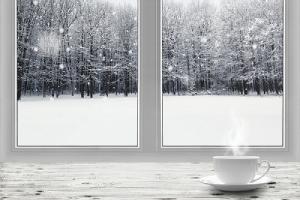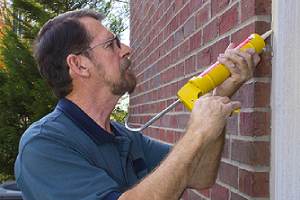 When cold weather sets in, drafts in the home that may have been virtually undetectable in summer become more noticeable and problematic. This leads many homeowners to research exterior caulking. One of the first pieces of advice you will encounter is that summer is the best time for this endeavor, but exterior caulking can be successful year-round if you use the right products for the job.
When cold weather sets in, drafts in the home that may have been virtually undetectable in summer become more noticeable and problematic. This leads many homeowners to research exterior caulking. One of the first pieces of advice you will encounter is that summer is the best time for this endeavor, but exterior caulking can be successful year-round if you use the right products for the job.
Tips For Exterior Caulk In Cold Weather
Applying caulk in winter requires a few extra precautions than applying it in warmer temperatures. First, it is essential to ensure the substrate is clean and dry. If any moisture is present, a thin layer of ice could form preventing the caulk from adhering to the substrate. If necessary, you can use a hair dryer to melt the ice and heat up the substrate. Alternatively, it can be cleaned using acetone or methyl ethyl ketone from a home improvement store; this has the added benefit of ensuring the substrate is clean enough to provide a tight bond.
It is also important to keep your tube of caulking warm until right before use. Even the highest-quality cold weather caulks will not flow smoothly from the tube when cold, which can make it challenging to get it down into the joint. The caulk should be stored inside prior to use. While caulking, you can also keep the tubes warm by placing them in a jar with warm water for a few minutes before using them.
Experts advise waiting until midday to caulk in cold weather to allow for any substrate movement as materials contract in cold weather and then expand when it is warm. Metals like aluminum and plastics such as vinyl are very prone to contracting and expanding with changes in temperature, although wood is less vulnerable to this issue.
It is also important to select a caulk that has high joint movement capability for cold weather caulking. The plus/minus value that appears on the tube can provide guidance in this regard; those marked as plus/minus 25 percent or higher are the best choice for cold weather caulking as they can stand up to more movement without splitting or cracking.
Have a Professional Complete Your Caulking Project
The Best Exterior Caulking Products For Cold Weather
![]() Generally speaking, latex caulking should be avoided in winter as the proper temperature range for applying this type of caulk is between 40 and 80 degrees Fahrenheit. However, other types of caulk can be applied even when the temperature drops below 0. Unlike latex, high-performance caulks with a rubber or silicone base are less likely to freeze.
Generally speaking, latex caulking should be avoided in winter as the proper temperature range for applying this type of caulk is between 40 and 80 degrees Fahrenheit. However, other types of caulk can be applied even when the temperature drops below 0. Unlike latex, high-performance caulks with a rubber or silicone base are less likely to freeze.
Titebond Weathermaster Sealant
Titebond’s Weathermaster Sealant is a premium polymer sealant that can be used on wood, vinyl, PVC, masonry and fiber cement. One of its biggest selling points is its ability to be extruded in low temperatures (the manufacturer recommends above 0 degrees F), making it a go-to product for cold weather applications. It adheres nicely to damp surfaces and remains permanently flexible without any shrinkage. Its joint movement capability is plus/minus 50 percent.
OSI Quad Window, Door & Siding Sealant
OSI Quad offers all-weather performance and three times the stretch. According to the manufacturer, it can be applied in temperatures ranging from 20 to 120 degrees Fahrenheit and is UV and water-resistant.
Gorilla Clear 100 Percent Silicone Sealant Caulk
 Gorilla is one of the most popular exterior caulks, known for its tough finish and versatility. It is made of 100 percent silicone and sets in just 30 minutes on all types of surfaces, even in winter or on rainy days. Completely waterproof and weatherproof, it is a good solution for gaps and cracks in doors and windows as it resists mildew and will not yellow, crack or shrink.
Gorilla is one of the most popular exterior caulks, known for its tough finish and versatility. It is made of 100 percent silicone and sets in just 30 minutes on all types of surfaces, even in winter or on rainy days. Completely waterproof and weatherproof, it is a good solution for gaps and cracks in doors and windows as it resists mildew and will not yellow, crack or shrink.
DAP 801 Caulk
This advanced polymer caulk is suited to vinyl, aluminum and wood siding and is permanently flexible. It does not shrink and has less than 1 percent volatile organic compounds. Appropriate for interior and exterior applications alike, its temperature range is from -65 degrees to 350 degrees Fahrenheit.
GE Sealants & Adhesives GE 5000 Advanced Silicone 2 Window & Door Sealant
This formula is 100 percent silicone, which means it stands up well to cold weather, and offers reliable protection from water damage and weather exposure. It also protects against mildew and mold damage. Boasting high flexibility and adhesion, it resists freezing temperatures and UV degradation and is ready for exposure to rain in as little as half an hour.
Speak To Professional Exterior Caulking Contractors On Cold Weather Caulk
If you are looking for professional exterior caulking contractors, get in touch with Waterproof Caulking & Restoration LLC. Their experts are skilled at selecting and applying the right type of caulk for a wide variety of conditions and materials.
